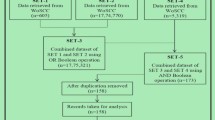Abstract
To demonstrate the importance and the actual research situation of Antarctic studies in the humanities and social sciences, we collected data from the SSCI and A&HCI covering a period of over 100 years and focused on the number of articles published each year, major journals, types of document, authors and their countries publishing the most articles, collaboration, the major research subjects covered, and citations. Comparisons were also made with the Arctic studies to show some similarities and differences. The results suggest that the research in the fields of humanities and social sciences has been in the long-run developing without interruption over 100 years. With regard to the number of articles in high-capacity journals, Geographical Journal performs best, followed by the Petermanns Geographische Mitteilungen and Scottish Geographical Magazine. The documentation is rather scattered without a strong cohesion, while book review and article are the two most common types of document. There haven’t many stable collaborated teams on Antarctic topics. Joyner, Savours, and Beck are the three authors having the highest number of publications. USA is the most active country while the most active research institute is University of Tasmania in Australia. The Antarctic expedition has been the main theme lasted for centuries. In addition, the research in the fields of humanities and social sciences has generated a lot of high-impact articles, among which the article entitled “Chemical concentrations of pollutant lead aerosols, terrestrial dusts and sea salts in Greenland and Antarctic snow strata” enjoys the highest citation counts.



Similar content being viewed by others
Notes
The database chosen for this research covers the data retrospectively early from 1898, but the data meeting the topics of this article begins from 1900.
References
Anderson, S. S., & Fedak, M. A. (1985). Grey seal males: Energetic and behavioural links between size and sexual success. Animal Behaviour, 33(3), 829–838.
Bastmeijer, K. (2004). Regulating antarctic tourism and the precautionary principle. American Journal of International Law, 98(4), 763–781.
Bruce, W. S. (1905). Scottish national antarctic expedition. Outline map of Laurie Island, South Orkneys, 1903. Scottish Geographical Magazine, 21(6), 322–323.
Dodds, K. (2010). Governing Antarctica: Contemporary challenges and the enduring legacy of the 1959 Antarctic treaty. Global Policy, 1(1), 108–115.
Hambro, E. (1974). Some notes on future of antarctic treaty collaboration. American Journal of International Law, 68(2), 217–226.
Hamner, W. M., Hamner, P. P., Strand, S. W., & Gilmer, R. W. (1983). Behavior of Antarctic Krill, Euphausia superba: Chemoreception, feeding, schooling, and molting. Science, 220(4595), 433–435.
Hamzah, B. A. (2010). Malaysia and the Southern Ocean: Revisiting the question of Antarctica. Ocean Development and International Law, 41(2), 186–195.
Hua, W., Yuan, S., Yan, M., & Li, Y. (2012). A quantitative analysis of Arctic related articles in the humanities and social sciences appearing in the world core journals. Scientometrics, 91(3), 703–718.
Ikuta, H. (2010). Eskimo language and Eskimo song in Alaska: A sociolinguistics of deglobalisation in endangered language. Pragmatics, 20(2), 171–189.
Johnston, T. F. (1991). Contemporary emphases in northern Eskimo dance. International Review of the Aesthetics and Sociology of Music, 22(2), 47–79.
Jones, C. D., & Lockhart, S. J. (2011). Detecting Vulnerable Marine Ecosystems in the Southern Ocean using research trawls and underwater imagery. Marine Policy, 35(5), 732–736.
Kaye, S. B., & Rothwell, D. R. (2002). Southern ocean boundaries and maritime claims: Another antarctic challenge for the law of the sea? Ocean Development and International Law, 33(3–4), 359–389.
Murozumi, M., Chow, T. J., & Patterson, C. (1969). Chemical concentrations of pollutant lead aerosols, terrestrial dusts and sea salts in Greenland and Antarctic snow strata. Geochimica et Cosmochimica Acta, 33(10), 1247–1294.
Naylor, S., Dean, K., & Siegert, M. (2008). The IGY and the ice sheet: Surveying Antarctica. Journal of Historical Geography, 34(4), 574–595.
Osterblom, H., & Sumaila, U. R. (2011). Toothfish crises, actor diversity and the emergence of compliance mechanisms in the Southern Ocean. Global Environmental Change-Human and Policy Dimensions, 21(3), 972–982.
Rolston, H. (2002). Environmental ethics in Antarctica. Environmental Ethics, 24(2), 115–134.
Stevenson, W. R. (2011). Science, the South Pole, and the Japanese expedition of 1910–1912. Endeavour, 35(4), 160–168.
Tomaselli, K. G. (2012). Consuming nature: Antarctica, penguins and pollution. Critical Arts: South-North Cultural and Media Studies, 26(3), 328–352.
Turchetti, S., Dean, K., Naylor, S., & Siegert, M. (2008). Accidents and opportunities: A history of the radio echo-sounding of Antarctica, 1958–79. British Journal for the History of Science, 41(150), 417–444.
Acknowledgments
This research is funded by the National Social Science Foundation of China (Grant No. 13BTQ043) and Chinese Arctic and Antarctic Administration (Grant No. CHINARE2013-04-05-03). The authors are grateful for the valuable comments and suggestions of anonymous reviewers and the editors, which significantly improved the article.
Author information
Authors and Affiliations
Corresponding author
Rights and permissions
About this article
Cite this article
Hua, W., Li, Y. & Yuan, S. A quantitative analysis of Antarctic related articles in humanities and social sciences appearing in the world core journals. Scientometrics 100, 273–286 (2014). https://doi.org/10.1007/s11192-013-1190-6
Received:
Published:
Issue Date:
DOI: https://doi.org/10.1007/s11192-013-1190-6




